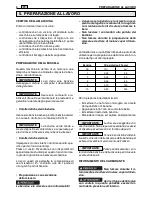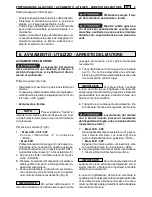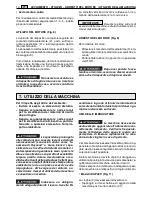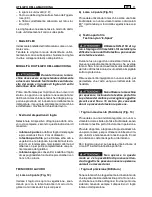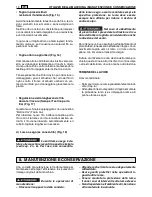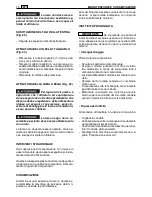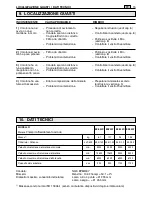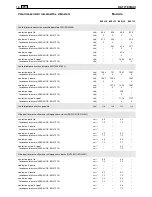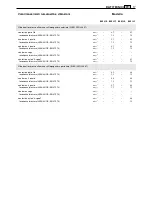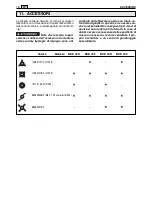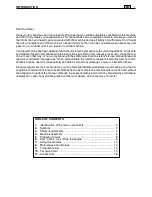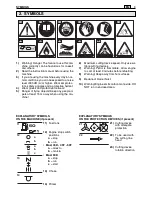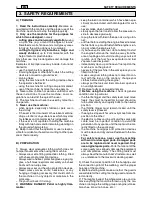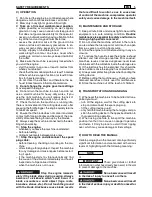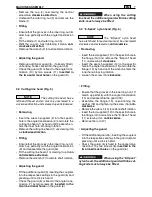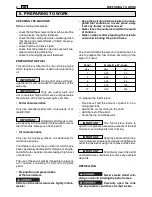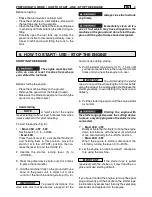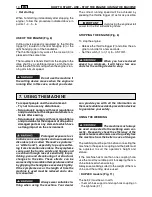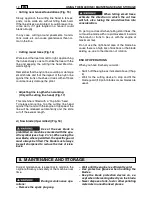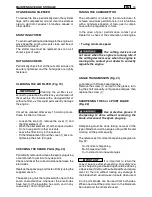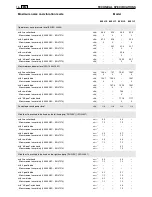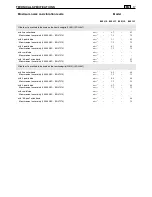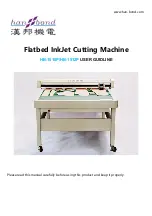
EN
A) TRAINING
1)
Read the instructions carefully.
Become ac-
quainted with the controls and the proper use of the
machine. Learn how to stop the engine quickly.
2)
Only use the machine for the purpose for
which it was designed,
namely
–
cutting grass and non-woody vegetation,
using
a nylon line (e.g. around the edges of lawns,
flowerbeds, walls, fences and small grassy areas
to tidy up the cutting done using a mower);
–
cutting tall grass, dry branches, twigs and
woody shrubs
of up to 2 cm diameter, with the
help of metal or plastic blades.
Any other use may be dangerous and damage the
machine.
Examples of improper use may include, but are not
limited to:
– use the machine for sweeping;
– trimming hedges or other jobs in which the cutting
device is not used on ground level;
– pruning trees;
– using the machine with the cutting device above
the operator's belt level;
– using the machine for cutting non-plant material;
– use of the machine by more than one person.
3) Never allow children or persons unfamiliar with
these instructions to use the machine. Local re-
gulations can restrict the age of the user.
4) The machine must never be used by more than
one person.
5)
Never use the machine:
– when people, especially children or pets are in
the vicinity;
– if the user is tired or unwell, or has taken medicine,
drugs, alcohol or any substances which may slow
his reflexes and compromise his judgement;
– if the user is not capable of holding the machine
firmly with two hands and/or remaining standing on
the ground whilst working.
6) Keep in mind that the operator or user is respon-
sible for accidents or hazards occurring to other peo-
ple or their property.
B) PREPARATION
1) Always wear adequate clothing which does not
hamper movements when using the machine.
– Always wear slim-fitting protective clothing, fitted
with shear-proof protection devices.
– Always wear a helmet, protective gloves, eye-gog-
gles, a half-mask respirator and safety anti-shear
boots with non-slip soles.
– Always wear ear and hearing protection devices.
– Never wear scarves, shirts, necklaces, or any
hanging or flapping accessory that could catch in
the machine or in any objects or materials in the
work area.
– Tie your hair back if it is long.
2)
WARNING: DANGER! Petrol is highly flam-
mable:
– keep the fuel in containers which have been spe-
cifically manufactured and homologated for such
use;
– never smoke when handling fuel;
– slowly open the fuel tank to allow the pressure in-
side to decrease gradually;
– top up the tank with fuel in the open air, using a fun-
nel;
– add fuel before starting the engine. Never remove
the fuel tank cap or add fuel while the engine is run-
ning or when the engine is hot;
– if you have spilt some fuel, do not attempt to start
the engine but move the machine away from the
area of spillage and avoid creating any source of
ignition until the fuel has evaporated and fuel
vapours have dissipated;
– immediately clean up all traces of fuel spilt on the
machine or on the ground;
– never start the machine in the same place you re-
filled it with fuel;
– make sure your clothing does not come into con-
tact with the fuel, on the contrary, change your
clothes before starting the engine;
– always put the tank and fuel container caps back
on and tighten well.
3) Replace faulty or damaged silencers.
4)
Before using the machine,
check its general
condition and in particular:
– the throttle trigger and the safety lever must move
freely, they must not need forcing and should re-
turn automatically and rapidly back to the neutral
position;
– the throttle trigger must remain locked until the
safety lever is pressed;
– the engine stop switch must easily move from one
position to the other;
– the electric cables and in particular the spark plug
cable must be in perfect condition to avoid the
generation of any sparks, and the cap must be cor-
rectly fitted on the spark plug;
– the machine handgrips and protection devices
must be clean and dry and well fastened to the ma-
chine;
–
For safety reasons, never use the machine
with worn or damaged parts. Damaged parts
are to be replaced and never repaired. Only
use original spare parts.
Parts that are not of the
same quality can seriously damage the equipment
and compromise safety. The cutting tools must
always bear the manufacturer’s trademark as well
as a reference to the maximum working speed.
5) Check the correct position of the handgrips and
the connection point of the webbing, and the proper
balance of the machine.
6) Before starting work make sure that the guards
are suitable for the cutting tool being used and are fit-
ted correctly.
7) Thoroughly inspect the whole work area and re-
move anything that could be thrown up by the ma-
chine or damage the cutting group or engine (stones,
branches, iron wire, bones, etc.).
4
SAFETY REQUIREMENTS
3. SAFETY REQUIREMENTS

